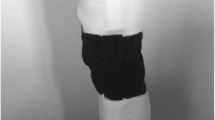Abstract
A key to the analysis of function after total hip replacement (THR) is the ability to identify gait adaptations specific to design features and surgical procedures. In a randomised controlled design, we evaluated the mechanics of gait after THR with a hip resurfacing system or conventional prosthesis. We also investigated whether gait adaptations returned to normal postoperatively. Similar improvements in mechanics of gait were found, except for peak abductor moments, which improved more in the conventional group. Gait speed increased significantly, but with no differences between groups. The increase in walking speed was reflected as significant improvement within groups in most kinematic and kinetic variables. Significant differences between the operated and non-operated hip were seen in all patients, but with no difference between groups. Mean curves of joint angle profiles and moments in all anatomical planes during a gait cycle revealed that gait impairment persisted with no differences between the conventional prosthesis and the resurfacing system.


Similar content being viewed by others
References
Asayama I, Chamnongkich S, Simpson KJ, Kinsey TL, Mahoney OM (2005) Reconstructed hip joint position and abductor muscle strength after total hip arthroplasty. J Arthroplasty 20(4):414–420
Bergmann G, Deuretzbacher G, Heller M, Graichen F, Rohlmann A, Strauss J, Duda GN (2001) Hip contact forces and gait patterns from routine activities. J Biomech 34(7):859–871
Bergmann G, Graichen F, Rohlmann A, Westerhoff P, Bender A, Gabel U, Heinlein B (2007) Loads acting on orthopaedic implants. Measurements and practical applications. Orthopade 36(3):195–202
Davis R, Ounpuu S, Tyburski D, Gage J (1991) A gait analysis data collection and reduction technique. Hum Mov Sci 10:575–587
Foucher KC, Hurwitz DE, Wimmer MA (2007) Preoperative gait adaptations persist one year after surgery in clinically well-functioning total hip replacement patients. J Biomech 40(15):3432–3437
Girard J, Lavigne M, Vendittoli PA, Roy AG (2006) Biomechanical reconstruction of the hip: a randomised study comparing total hip resurfacing and total hip arthroplasty. J Bone Joint Surg Br 88(6):721–726
Gore DR, Murray MP, Gardner GM, Sepic SB (1985) Hip function after total vs. surface replacement. Acta Orthop Scand 56(5):386–390
Heller MO, Bergmann G, Kassi JP, Claes L, Haas NP, Duda GN (2005) Determination of muscle loading at the hip joint for use in pre-clinical testing. J Biomech 38(5):1155–1163
Hulet C, Hurwitz DE, Andriacchi TP, Galante JO, Vielpeau C (2000) Functional gait adaptations in patients with painful hip. Rev Chir Orthop Reparatrice Appar Mot 86(6):581–589
Hurwitz DE, Hulet CH, Andriacchi TP, Rosenberg AG, Galante JO (1997) Gait compensations in patients with osteoarthritis of the hip and their relationship to pain and passive hip motion. J Orthop Res 15(4):629–635
Kadaba MP, Ramakrishnan HK, Wootten ME (1990) Measurement of lower extremity kinematics during level walking. J Orthop Res 8(3):383–392
Long WT, Dorr LD, Healy B, Perry J (1993) Functional recovery of noncemented total hip arthroplasty. Clin Orthop Relat Res 288:73–77
Madsen MS, Ritter MA, Morris HH, Meding JB, Berend ME, Faris PM, Vardaxis VG (2004) The effect of total hip arthroplasty surgical approach on gait. J Orthop Res 22(1):44–50
Marker DR, Strimbu K, McGrath MS, Zywiel MG, Mont MA (2009) Resurfacing versus conventional total hip arthroplasty—review of comparative clinical and basic science studies. Bull NYU Hosp Jt Dis 67(2):120–127
McGrory BJ, Morrey BF, Cahalan TD, An KN, Cabanela ME (1995) Effect of femoral offset on range of motion and abductor muscle strength after total hip arthroplasty. J Bone Joint Surg Br 77(6):865–869
Miki H, Sugano N, Hagio K, Nishii T, Kawakami H, Kakimoto A, Nakamura N, Yoshikawa H (2004) Recovery of walking speed and symmetrical movement of the pelvis and lower extremity joints after unilateral THA. J Biomech 37(4):443–455
Mont MA, Seyler TM, Ragland PS, Starr R, Erhart J, Bhave A (2007) Gait analysis of patients with resurfacing hip arthroplasty compared with hip osteoarthritis and standard total hip arthroplasty. J Arthroplasty 22(1):100–108
Murray MP, Gore DR, Brewer BJ, Mollinger LA, Sepic SB (1981) Joint function after total hip arthroplasty: a four-year follow-up of 72 cases with Charnley and Muller replacements. Clin Orthop Relat Res 157:119–124
Naal FD, Maffiuletti NA, Munzinger U, Hersche O (2007) Sports after hip resurfacing arthroplasty. Am J Sports Med 35(5):705–711
Ong KL, Kurtz SM, Manley MT, Rushton N, Mohammed NA, Field RE (2006) Biomechanics of the Birmingham hip resurfacing arthroplasty. J Bone Joint Surg Br 88(8):1110–1115
Shih CH, Du YK, Lin YH, Wu CC (1994) Muscular recovery around the hip joint after total hip arthroplasty. Clin Orthop Relat Res 302:115–120
Vardaxis VG, Allard P, Lachance R, Duhaime M (1998) Classification of able-bodied gait using 3-D muscle powers. Hum Mov Sci 17(1):121–136
Wall JC, Ashburn A, Klenerman L (1981) Gait analysis in the assessment of functional performance before and after total hip replacement. J Biomed Eng 3(2):121–127
White SC, Lifeso RM (2005) Altering asymmetric limb loading after hip arthroplasty using real-time dynamic feedback when walking. Arch Phys Med Rehabil 86(10):1958–1963
Yun AG (2006) Sports after total hip replacement. Clin Sports Med 25(2):359–364
Acknowledgement
The project was supported by grants from Forskningsinitiativet Århus Amt, The Society of Danish Physiotherapists and SAHVA.
Conflict of interest
The authors declare that they have no conflict of interest.
Author information
Authors and Affiliations
Corresponding author
Rights and permissions
About this article
Cite this article
Petersen, M.K., Andersen, N.T., Mogensen, P. et al. Gait analysis after total hip replacement with hip resurfacing implant or Mallory-head Exeter prosthesis: a randomised controlled trial. International Orthopaedics (SICOT) 35, 667–674 (2011). https://doi.org/10.1007/s00264-010-1040-6
Received:
Revised:
Accepted:
Published:
Issue Date:
DOI: https://doi.org/10.1007/s00264-010-1040-6




